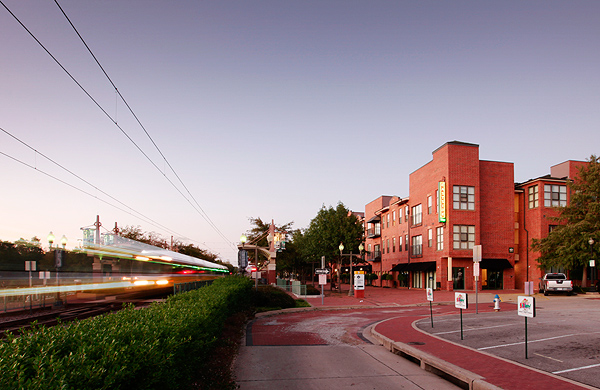People often speak of DART light rail as a disappointment. So much was promised. We were to have Grand Central Terminal and the London Tube and the hyper-efficient Hong Kong metro and world class, world class, world class. There were to be new, walkable neighborhoods sprung from the earth as if by pop-up book.
So far, we’ve seen something less. Our disappointment must be tempered with the knowledge that it takes at least a generation for a city to adapt to new bones. North Texas didn’t become a wasteland of billboards, parking lots, and throwaway buildings when the first highway was built. It took 50 years of careful cultivation. But whatever disappointment there might be, it hasn’t stopped cities from fighting over future rail alignments. Into the ring step Richardson and Plano, both of which want the Cotton Belt Rail Line.
The Cotton Belt as imagined in DART’s 2030 plan will be built with help from the Fort Worth Transportation Authority, better known as The T. Eventually, it will run 68 miles, going from southwest Fort Worth, through downtown, to DFW Airport, through Addison, Richardson, Plano, Carrollton, and eventually to Wylie. Unlike a typical DART line, this will be “heavy,” or commuter rail, like the Trinity Railway Express (TRE), except with modern cars. DART already owns most of the needed land.
If the existing Cotton Belt route is used, Richardson would get only one stop, just north of UT Dallas. The city wants two stops, though, preferring a realignment that would veer south at the interchange of highways 190 and 75, creating a rail hub at the Bush Turnpike Station of the DART Red Line. The new alignment would leverage a proposed mixed-use, transit-oriented development on vacant land that surrounds the Bush Turnpike Station. Richardson envisions its own Addison Circle or Legacy Town Center on the land between the interchange and the intersection of Renner and Plano roads.
Plano has different ideas. City leaders there want the Cotton Belt to maintain its older, historical alignment, which travels under 190 in Richardson before turning north and crossing over 75, where a new 12th Street station would connect with the DART Red Line and serve downtown Plano. Along with a proposed station farther east at Shiloh Road, Plano would have two stations. Plano sees the transit hub as an opportunity to expand its successful downtown revitalization southward.
Since each city has its defensible biases, perhaps it is up to the rest of us to determine where the trains will run. One difference between the competing sites is that Richardson’s is ready for development, and Plano’s isn’t. Warehouses now occupy where the station south of downtown would be built. It’s difficult, though, to imagine that they’ll still be there in 15 years. In that way, both sites are clean slates by the time the Cotton Belt arrives. Call it a wash on that count.
The important difference between the two sites is density. Or call it heart and soul. Any successful neighborhood development has to work before the rail arrives. On this count, Richardson offers empty land, while Plano has been working on its site for 15 years.
I visited downtown Plano last year. Even in the recession, the thwack-thwack-thwack of hammers filled the air with the optimism of new construction. I counted eight storefront renovations or new construction projects. It felt worlds away from the highway interchange that looms over the Richardson site.
For too long, the North Texas real estate market has badly overvalued highway-fronting property, building too much square footage, only to watch as developments devolve into the inevitable gas stations and strip clubs. The mistake is easy to understand when you think about the traditional city, where, much like the internet, value springs from traffic, the number of people moving past your site. The most traffic is on the highway. But with those highway speeds comes reduced accessibility. To reach a place by highway, half the time you’re heading in the wrong direction. Each backtrack, extra turn, U-turn, or missed exit diminishes the value of that property, a condition Jane Jacobs referred to as “a border vacuum.”
K Avenue running through downtown Plano can be the prototypical “high street” that nearby neighborhoods organize around. It is one of the better opportunities in North Texas to provide order, clarity, and focus to a real estate market that lacks all of the above, to allow many hands to work at once as opposed to a single owner of an isolated piece of property. We should support downtown Plano’s continued revitalization and build upon its momentum, not send the trains past yet another roadside attraction. With sincerest apologies, Richardson.
Write to [email protected].






